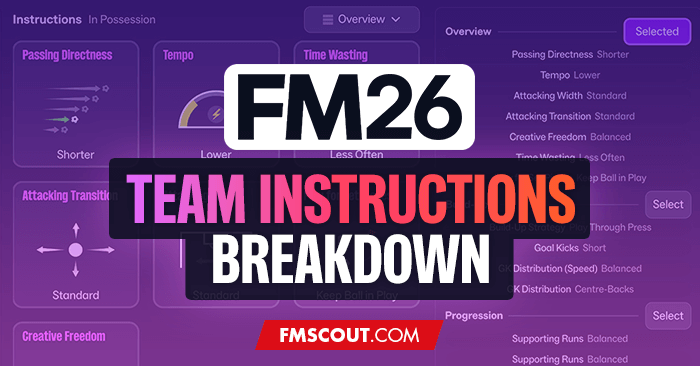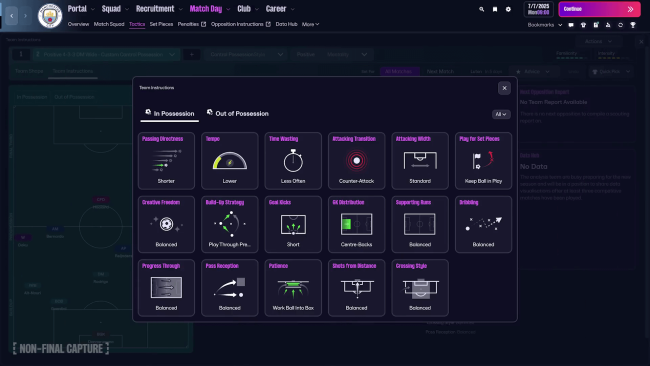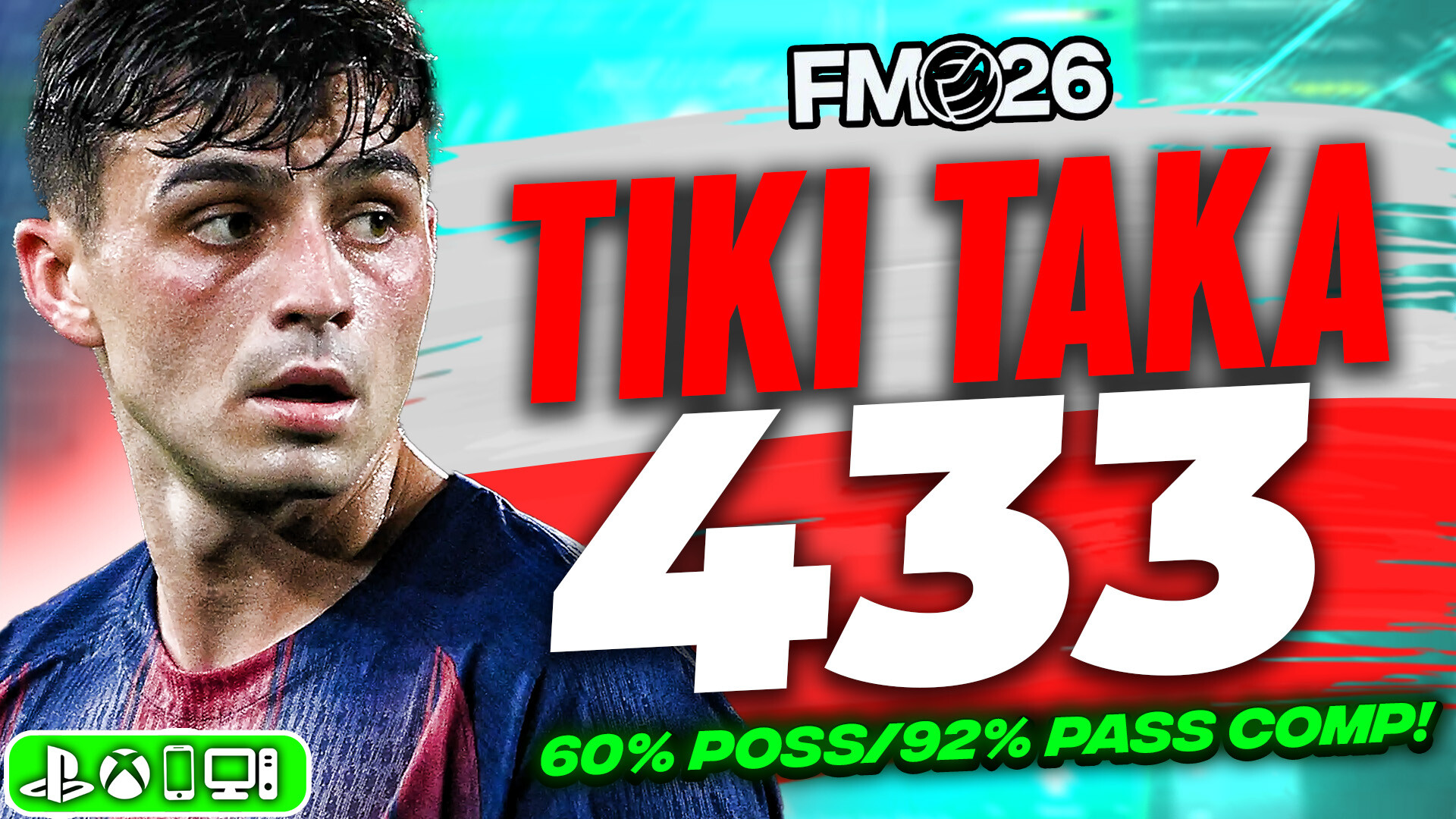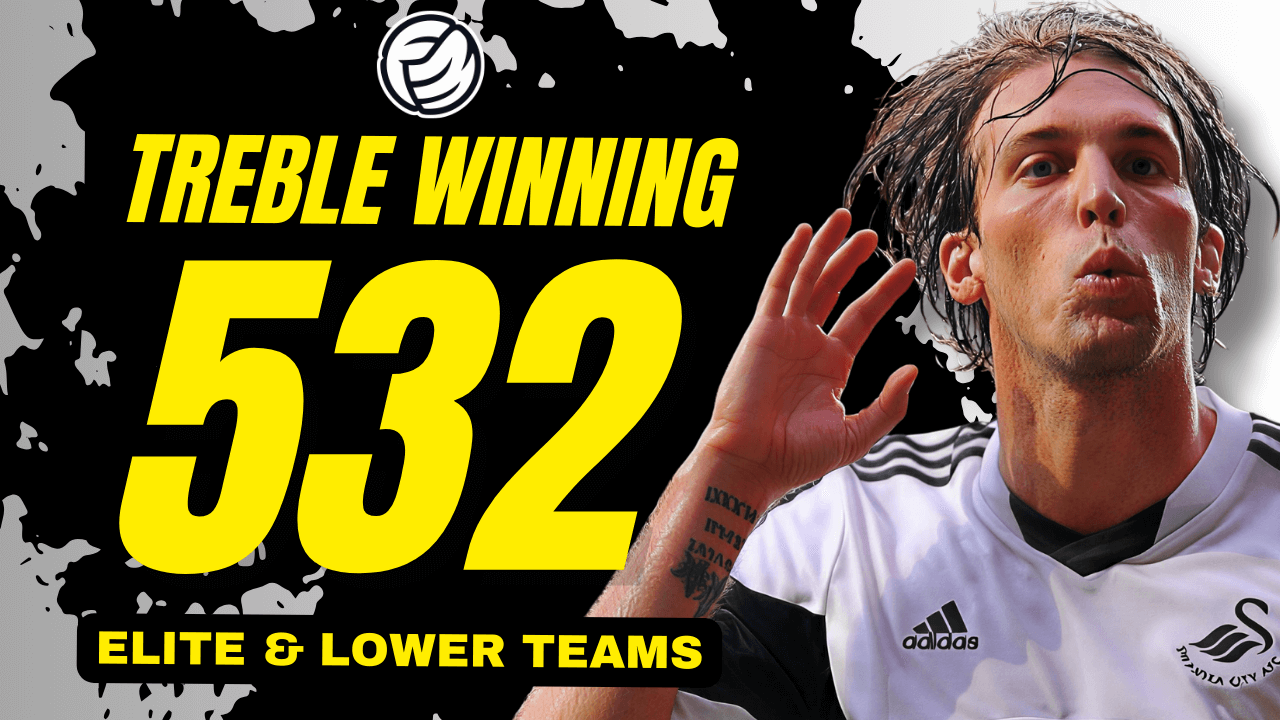
Team Instructions are no longer a simple list of settings - they're now organized by context, split between possession phases, and tied to a revolutionary dual formation system.
This guide explains every team instruction in FM26, how they work together, and how to build tactics that actually match what you see in real football.
Whether you're new to the game or a veteran adjusting to the changes, this is your complete reference.
- How the new dual formation system works
- Every In Possession and Out of Possession instruction explained
- Which instructions work together (and which conflict)
- How to convert your FM24 tactics to FM26
- Complete tactical examples for different playing styles
This is a comprehensive guide designed for both beginners and experienced players. Each instruction is explained in simple terms, with clear examples of when to use it and what player attributes you need.
Use the table of contents below to jump to any section.
Guide Contents:
- Introduction: What Changed in FM26
- Understanding the New System
- In Possession Instructions
- Out of Possession Instructions
- Phase Breakdown Reference
- Instruction Interactions
- Common Mistakes to Avoid
- Tactical Examples
- Quick Reference: FM24 to FM26 Conversion
What Changed in FM26
Football Manager 26 introduces the biggest tactical overhaul in the game's history.Team Instructions have been completely redesigned to match how modern football actually works.
The Three Major Changes:
- Dual Formation System - You now set separate formations for In Possession and Out of Possession. Your team automatically switches between these formations based on whether you have the ball.
- Context-Sensitive Instructions - Instructions are organized by the phase of play they affect. In Possession instructions appear in different views (Overview, Buildup, Progression, Final Third) based on which area of the pitch you are focusing on.
- Visual Feedback - The new Visualizer shows you exactly how your instructions affect player positioning in each third of the pitch. When you change an instruction, you see the impact immediately.
Why These Changes Matter:
Modern football teams defend in one shape and attack in another.Think of how Manchester City defends in a compact 4-4-2 but attacks with full-backs pushing into midfield, creating a 2-3-5 shape.
FM26 finally lets you replicate this reality.
The old system forced you to use workarounds and player instructions to achieve what top teams do naturally. The new system makes it simple and clear.
For a complete overview of all FM26 changes, see our Football Manager 2026 new features guide.
Understanding the New System
How Dual Formations Work

Your team now has two formations:
- In Possession Formation - How your team is positioned when you have the ball
- Out of Possession Formation - How your team is positioned when the opponent has the ball
For example, your left-back might be a Full-Back (Support) when defending but push forward as a Wing-Back (Attack) when you have the ball.
The dual formation system fundamentally changes how you build tactics. For a detailed comparison with FM24, check our FM24 vs FM26 comparison guide.
Understanding Phases and Pitch Areas
FM26 organizes instructions based on where and when they matter.
In Possession Phases
- Overview - See all your In Possession instructions at once
- Buildup - Controls how you start attacks from deep positions (goalkeeper distribution, building from the back)
- Progression - Controls how you move the ball through midfield
- Final Third - Controls how you create and finish chances
Out of Possession Phases
- Overview - See all your Out of Possession instructions at once
- High Press - Instructions for when you press high up the pitch (opponent's half)
- Mid Block - Instructions for when you defend around the halfway line
- Low Block - Instructions for when you defend deep in your own half
The Visualizer
The Visualizer is the green pitch display on the left side of your tactics screen. It shows your formation in three views: Defensive Third, Middle Third, and Final Third.
As you change instructions, watch the Visualizer. You will see players moving into new positions, highlighted zones showing affected areas, and movement arrows indicating runs.
This helps you spot problems before you play a match.
Key Principle: Context Over Complexity
The old FM system gave you every instruction all at once. FM26 shows you instructions only when they are relevant.When viewing your Final Third, you see instructions about crossing and shooting. When viewing your Buildup phase, you see instructions about goalkeeper distribution.
This context-sensitive approach makes tactics easier to understand and build, even for beginners.
In Possession Instructions
These instructions control what your team does when you have the ball.
Passing Directness
Appears in: Overview
Options: Much Shorter / Shorter / Balanced / More Direct / Much More Direct
- Much Shorter / Shorter - Many short passes. Players take extra touches. Good for possession-based styles.
- Balanced - Mix of short and longer passes based on situation.
- More Direct / Much More Direct - Longer passes to get the ball forward quickly. Good for counter-attacking.
Tempo
Appears in: Overview
Options: Lower / Standard / Higher
- Lower - Players take more time on the ball. Slower build-up. Good for controlling the game.
- Higher - Quick passing and decision-making. Fast transitions.
Works Well With: Lower tempo + shorter passing = patient possession. Higher tempo + more direct = fast counter-attacking.
Time Wasting
Appears in: Overview
Options: Less Often / Standard / More Often
Attacking Transition
Appears in: Overview
Options: Counter-Attack / Standard / Patient Build-Up
- Counter-Attack - Players immediately look to attack. Fast transitions. Forward runs triggered instantly.
- Patient Build-Up - Players slow down after winning the ball. Reorganize before attacking.
Use Patient Build-Up When: You want to maintain possession. Your team lacks pace. Combined with Shorter passing and Lower tempo.
Attacking Width
Appears in: Overview
Options: Much Narrower / Narrower / Standard / Wider / Much Wider
- Narrower - Players stay central. Good for playing through the center.
- Wider - Players spread across the pitch. Good for wing play and crossing.
Creative Freedom
Appears in: Overview
Options: More Disciplined / Balanced / More Expressive
- More Disciplined - Players stick to roles. Less risk-taking. Safer passing.
- More Expressive - Players encouraged to take risks. More dribbling and creative passes.
Play for Set Pieces
Appears in: Overview
Options: Keep Ball in Play / Standard
- Keep Ball in Play - Avoid putting ball out. Good when winning and controlling the game.
- Standard - Normal play. Will try to win corners and free kicks.
Build-Up Strategy
Appears in: Buildup
Options: Play Through Press / Mixed / Direct
- Play Through Press - Pass through opponent pressure. Players drop deep to receive.
- Direct - Bypass pressure with long balls.
Goal Kicks
Appears in: Buildup
Options: Short / Mixed / Long
- Short - Goalkeeper plays short to defenders. Starts attacks from the back.
- Long - Goalkeeper kicks long to forwards or midfielders.
GK Distribution (Speed)
Appears in: Buildup
Options: Slower / Balanced / Faster
- Slower - Goalkeeper waits for teammates to get into position.
- Faster - Goalkeeper distributes immediately. Quick transitions.
GK Distribution (Target)
Appears in: Buildup
Options: Centre-Backs / Full-Backs / Midfielders / Forwards
Pass Reception
Appears in: Progression, Final Third
Options: Balanced / Overlapped
- Balanced - Normal receiving positions.
- Overlapped - Players move into gaps between opponents to receive with more space.
Dribbling
Appears in: Progression, Final Third
Options: Reduced / Balanced / Encouraged
- Reduced - Players pass more, dribble less. Safer approach.
- Encouraged - Players take on opponents more often.
Supporting Runs
Appears in: Progression
Options: Both Flanks / One Flank / Balanced
- Both Flanks - Supporting runs from both wings.
- One Flank - Focus runs on one side. Creates overloads.
Progress Through
Appears in: Progression
Options: Left / Balanced / Right
Patience
Appears in: Final Third
Options: Work Ball Into Box / Balanced / Less Often
- Work Ball Into Box - Very patient. Pass until clear chance appears. Avoids long shots and early crosses.
- Less Often - Shoot earlier and cross sooner.
Shots from Distance
Appears in: Final Third
Options: Reduced / Balanced / Encouraged
Attribute Check: Players need Long Shots 13+ to be effective. Below that, they waste possession.
Crossing Style
Appears in: Final Third
Options: Low Crosses / Balanced / High Crosses
- Low Crosses - Driven crosses along the ground. Faster and harder to defend.
- High Crosses - Lofted crosses into the box. Target tall forwards.
Out of Possession Instructions
These instructions control how your team defends when the opponent has the ball.
Line of Engagement
Appears in: Overview
Options: High Press / Mid Block / Low Block
- High Press - Press high up the pitch in the opponent's half.
- Mid Block - Defend around the halfway line.
- Low Block - Defend deep in your own half.
Stamina Warning: High Press is exhausting. Rotate heavily.
Defensive Line
Appears in: Overview
Options: Deeper / Standard / Higher / Much Higher
- Deeper - Defenders sit deep, closer to your goal.
- Higher / Much Higher - Defenders push up. Compresses space.
Speed Matters: If your defenders have Pace below 12, using Higher is risky. Fast opponents will run in behind.
Defensive Line Behaviour
Appears in: OverviewOptions: Balanced / Offside Trap / Step Up
- Balanced - Standard behavior.
- Offside Trap - Defenders aggressively step up to catch attackers offside. High-risk, high-reward.
- Step Up - Defenders push forward to maintain compactness without the risk of offside trap.
Trigger Press
Appears in: Overview
Options: Less Often / Balanced / More Often
- Less Often - Passive pressing. Hold shape.
- More Often - Aggressive pressing. Close down immediately.
Defensive Transition
Appears in: Overview
Options: Counter-Press / Standard / Regroup
- Counter-Press - Players immediately press to win the ball back within 5-6 seconds. This is Gegenpressing.
- Regroup - Players drop into defensive shape. Prioritizes organization.
Use Regroup When: Your team lacks fitness. You face fast attackers who punish disorganization. You use Low Block.
Energy Cost: Counter-Press is extremely demanding. You need squad depth.
Tackling
Appears in: Overview
Options: Ease Off / Standard / Aggressive
- Aggressive - Harder tackling. More fouls but more ball wins.
- Ease Off - Careful tackling. Fewer fouls and cards.
Pressing Trap
Appears in: High Press, Mid Block, Low Block
Options: Balanced / Active
- Balanced - Standard pressing.
- Active - Players coordinate to surround the ball carrier and force mistakes.
Short Goalkeeper Distribution
Appears in: High Press
Options: Yes / No
- Yes - Forwards press the goalkeeper. Prevents them from playing short.
- No - Forwards hold position.
Cross Engagement
Appears in: High Press, Mid Block, Low Block
Options: Hold Position / Balanced / Contest
- Hold Position - Defenders maintain positions rather than rushing to contest.
- Contest - Defenders aggressively close down crossing opportunities.
Phase Breakdown Reference
In Possession Phases
Overview Phase includes:- Passing Directness
- Tempo
- Time Wasting
- Attacking Transition
- Attacking Width
- Creative Freedom
- Play for Set Pieces
- Build-Up Strategy
- Goal Kicks
- GK Distribution (Speed)
- GK Distribution (Target)
- Pass Reception
- Dribbling
- Supporting Runs
- Progress Through
- Dribbling
- Patience
- Shots from Distance
- Crossing Style
- Pass Reception
Out of Possession Phases
Overview Phase includes:- Line of Engagement
- Defensive Line
- Defensive Line Behaviour
- Trigger Press
- Defensive Transition
- Tackling
- Pressing Trap
- Short Goalkeeper Distribution
- Cross Engagement
- Pressing Trap
- Cross Engagement
- Pressing Trap
Instruction Interactions
Instructions That Work Well Together
Possession Style:- Shorter Passing + Lower Tempo + Play Through Press + Work Ball Into Box + Reduced Shots from Distance
- Why: Every instruction supports patient possession football
- More Direct Passing + Higher Tempo + Counter-Attack Transition + Low Block + Regroup + Less Often Patience
- Why: Defend deep and organized, explode forward quickly when winning the ball
- High Press + Higher Defensive Line + More Often Trigger Press + Counter-Press + Active Pressing Traps + Counter-Attack Transition
- Why: Press high, counter-press when losing the ball, attack quickly when winning it back
- Warning: Most physically demanding style. Needs exceptional fitness across the squad.
Conflicting Instructions to Avoid
Conflict 1: Direct Passing + Work Ball Into Box
Problem: Direct tells players to go forward quickly. Work Ball Into Box tells them to be patient. These contradict each other.Fix: Use Direct with Less Often patience, or Shorter with Work Ball Into Box.
Conflict 2: High Press + Deep Defensive Line
Problem: Creates huge gap between midfield and defense.Fix: High Press must pair with Higher Defensive Line. Low Block must pair with Deeper Defensive Line.
Conflict 3: Counter-Press + Low Block + Regroup
Problem: Counter-Press requires players high up to press. Low Block + Regroup tells them to drop deep.Fix: Counter-Press works with High Press and Higher Line. Regroup works with Low Block and Deeper Line.
Conflict 4: Play Through Press + Long Goal Kicks
Problem: Strategy is ignored every goal kick.Fix: Play Through Press needs Short Goal Kicks. Direct strategy needs Long Goal Kicks.
Conflict 5: More Expressive + Low Quality Players
Problem: Players try fancy skills they cannot execute. Constant turnovers.Fix: Only use More Expressive with Flair 14+, Dribbling 14+, Creativity 14+. Otherwise use Balanced.
The Golden Rule
Every instruction should support your overall tactical approach.Ask yourself: "What am I trying to do?" Then make sure every instruction supports that goal.
If you see conflicting ideas (patient + direct, high press + deep defense), you have a problem.
Common Mistakes to Avoid
1. Using "Balanced" for Everything
Problem: Creates a generic team with no identity.Fix: Choose a clear approach (possession, counter-attack, high press) and set instructions to support it.
2. Copying Instructions Without Checking Player Attributes
Problem: Instructions that work for someone else fail for you because your players lack the necessary attributes.Fix: Before using High Press, check Work Rate and Stamina (14+). Before using Play Through Press, check defender Passing and Composure (13+). Before using High Crosses, check striker Heading (16+).
3. Ignoring the Visualizer
Problem: Creating gaps in formation without realizing it.Fix: Watch the Visualizer after setting each instruction. Look for gaps, overcrowding, or poor positioning.
4. Pressing High With Slow Defenders
Problem: Fast opponents run in behind constantly.Fix: High Press + Higher Defensive Line needs defenders with minimum Pace 12, Acceleration 11. If your defenders are slow, use Mid Block or Low Block instead.
5. Over-Pressing Without Stamina
Problem: Team exhausted by 60 minutes. Concede late goals.Fix: High Press needs team average Stamina 13+. Counter-Press needs 14+. Both together need 15+. If you lack stamina, use Mid Block and Balanced pressing.
6. Changing Everything After One Bad Result
Problem: No idea what caused the problem or what fixed it.Fix: Identify the specific problem (conceding from counters, not creating chances, etc.). Change 1-2 instructions to fix that problem. Test. Then evaluate.
Tactical Examples
Example 1: High Pressing / Gegenpressing (Klopp / Liverpool Style)
Philosophy: Press aggressively high. Win the ball back within 5-6 seconds. Attack quickly with intensity.Formation In Possession: 4-3-3
Formation Out of Possession: 4-3-3 compact
Key Instructions:
In Possession:
- Passing Directness: Balanced or More Direct
- Tempo: Higher
- Attacking Transition: Counter-Attack
- Attacking Width: Standard
- Line of Engagement: High Press
- Defensive Line: Higher
- Trigger Press: More Often
- Defensive Transition: Counter-Press (This is the key)
- Tackling: Standard or Aggressive
- Pressing Trap: Active
- Short Goalkeeper Distribution: Yes
- CRITICAL: Entire team needs Work Rate 14+, Stamina 14+, Teamwork 13+
- Forwards: Pace 14+, pressing ability
- Center-Backs: Pace 13+, positioning
- Goalkeeper: Sweeper keeper
Best Against: Possession teams, teams weak under pressure.
Warning: Most physically demanding style. Rotate heavily. Expect tiredness by 65-70 minutes.
Example 2: Counter-Attacking (Mourinho / Simeone Style)
Philosophy: Defend deep and organized. Absorb pressure. Win the ball. Attack quickly with pace.Formation In Possession: 4-4-2 or 5-3-2
Formation Out of Possession: Same, very compact
Key Instructions:
In Possession:
- Passing Directness: More Direct
- Tempo: Higher
- Attacking Transition: Counter-Attack (Critical)
- Attacking Width: Standard or Narrower
- Creative Freedom: More Disciplined
- Time Wasting: More Often (when winning)
- Build-Up Strategy: Direct
- Goal Kicks: Long or Mixed
- Patience: Less Often
- Shots from Distance: Encouraged
- Line of Engagement: Low Block (Critical)
- Defensive Line: Deeper
- Trigger Press: Less Often
- Defensive Transition: Regroup (Critical)
- Tackling: Standard
- Cross Engagement: Hold Position
- Forwards: Pace 15+, Acceleration 14+, counter-attacking ability
- Midfielders: Work rate, stamina, tackling (defensive solidity)
- Defenders: Positioning 14+, Tackling 14+ (pace less important because you defend deep)
Best Against: Possession-heavy teams, stronger teams (underdog situations).
Key Principle: Defensive discipline more important than attacking quality. One mistake loses the game.
Quick Reference: FM24 to FM26 Conversion
If you have existing FM24 tactics you want to adapt, this conversion table will help. For step-by-step guidance on converting your specific tactics, see our dedicated guide on converting FM24 tactics to FM26.| FM24 Instruction | FM26 Equivalent | Where to Find It |
|---|---|---|
| Play Out of Defence | Build-Up Strategy: Play Through Press + Goal Kicks: Short + GK Distribution: Centre-Backs | In Possession → Buildup |
| Higher Tempo | Tempo: Higher | In Possession → Overview |
| More Direct Passing | Passing Directness: More Direct | In Possession → Overview |
| Shorter Passing | Passing Directness: Shorter | In Possession → Overview |
| Work Ball Into Box | Patience: Work Ball Into Box | In Possession → Final Third |
| Hit Early Crosses | Patience: Less Often + Crossing Style: Standard | In Possession → Final Third |
| Get Stuck In | Tackling: Aggressive | Out of Possession → Overview |
| Counter | Attacking Transition: Counter-Attack | In Possession → Overview |
| Counter-Press | Defensive Transition: Counter-Press | Out of Possession → Overview |
| Higher Defensive Line | Defensive Line: Higher | Out of Possession → Overview |
| Lower Defensive Line | Defensive Line: Deeper | Out of Possession → Overview |
| Higher Line of Engagement | Line of Engagement: High Press | Out of Possession → Overview |
| Prevent Short GK Distribution | Short Goalkeeper Distribution: Yes | Out of Possession → High Press |
| Use Offside Trap | Defensive Line Behaviour: Offside Trap | Out of Possession → Overview |
New and Redesigned FM26 Instructions
- Creative Freedom - Controls player expression (replaces old "risk" concept)
- Pass Reception - Receiving patterns (Balanced vs Overlapped)
- Progress Through - Which side you progress through (Left/Balanced/Right)
- Supporting Runs - Where runs come from (Both Flanks/One Flank/Balanced)
- Time Wasting - Control tempo when winning
- Play for Set Pieces - Keep ball in play vs winning set pieces
- GK Distribution (Speed) - How quickly keeper distributes
- Line of Engagement - High Press/Mid Block/Low Block (clearer than before)
- Trigger Press - How often to press (More/Balanced/Less Often)
- Pressing Trap - Coordinated pressing (Active/Balanced)
- Cross Engagement - How to defend crosses
Major Conceptual Changes
Dual Formations: You now set separate In Possession and Out of Possession formations. This lets you replicate how real teams attack in one shape and defend in another. Learn more about the tactics overhaul.Context-Sensitive Organization: Instructions appear only in relevant phases. No more overwhelming long lists.
Transitions Relocated: Attacking Transition moved to In Possession. Defensive Transition moved to Out of Possession. More logical organization.
Player Roles Revamped: Roles work within the dual formation system. Your left-back can be defensive when out of possession but attacking when in possession.
Final Tips
- Start simple - Set 5-6 core instructions first. Add complexity as you identify problems.
- Watch your matches - Do not just simulate. Watch the first 20 minutes and final 20 minutes to see how your tactic performs.
- Use the Data Hub - FM26 links it directly to Team Instructions. Check where you create chances, where you concede, and pressing effectiveness.
- Match instructions to your squad - The best tactic is useless if your players cannot execute it. Always check attributes.
- Give it time - Do not judge after one match. Give 5-10 matches to see trends.
- Adapt to opponents - Make smart adjustments:
- Vs high pressing: Shorter passing, Lower Tempo
- Vs deep defense: Encouraged Shots from Distance, Wider width
- Vs counter-attacking: Regroup instead of Counter-Press
- When winning late: Time Wasting More Often
- Vs high pressing: Shorter passing, Lower Tempo
- Rotate for high-intensity tactics - If using High Press and Counter-Press, rotate 3-4 players every match.
- Don't copy blindly - Understand WHY instructions work together. Adapt to your squad's strengths.
Conclusion
FM26's Team Instructions represent a major evolution in Football Manager tactics.The dual formation system, context-sensitive organization, and visual feedback make tactics more realistic and intuitive than ever.
Key takeaways:
- Dual formations let you attack and defend in different shapes
- Instructions are organized by when and where they matter
- The Visualizer shows you exactly what your instructions do
- Instructions must work together to support your tactical approach
- Player attributes determine if instructions will work
Welcome to the new era of Football Manager tactics.
This guide covers all team instructions in Football Manager 2026 based on pre-release information. Some details may change in the final release.





![FM26 2025-26 Real Fixture & Results [26-11-2025]](https://www.fmscout.com/datas/users/realresult_thumb_25_26_fm26_257759.png)

![[FM26] Leagues Mega Pack by @Timo@ (212 Nations + 24 Feminines + 7 Others)](assets/downloads/fm26/fm26-leagues-pack-by-timo.th.png)



Discussion: FM26 Team Instructions: Complete Breakdown
No comments have been posted yet..